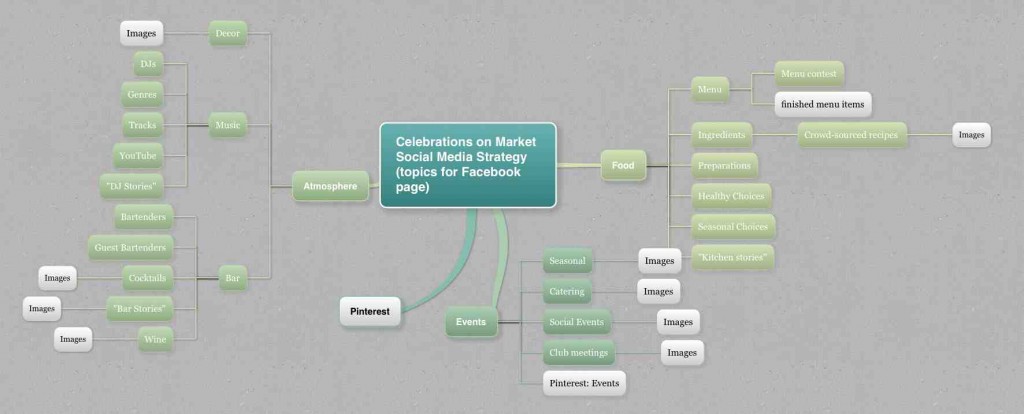
Tag Archives: brand development
Brand Culture: Creating a community around your small business brand…a primer
Years ago, when the web was relatively young, I remember business owners asking me to build them a website with the rationale that “they just needed one.” There was no more discussion than that. Me, being young and hungry, built them a site that, for the time and my skill level, looked great. But then they sat and luckily, only a few of those sites from that time still exist.
One of the main reasons that I am glad that they aren’t around anymore is that no one, including me, connected with this project ever asked the question: What do you want this site to do for you? Of course now I ask the question as a matter of routine.
What I am noticing now that time has passed, business owners are doing the same thing with social media. ” We need a social media presence” and that’s the end of the sentence, and I suspect, the end of the thought process. That’s unfortunate, because with social media, you’re playing with fire.
So how does a company build a community around their brand? There are a few steps, and not all of them are simple.
Define your brand as a persona: What does your brand like? Dislike? Stand for? Stand against? What is the ethos of your brand? What is your brand promise? Your brand story? And what kind of car would it drive? Some of these questions sound silly, but you’ll need to look at your brand as an individual actor amongst a group of actors in the social media ecosystem.
Once you have defined your brand as a persona, then develop a list of keywords that have a connection to your brand. This is a good time to break out that mind-mapping app and gather people who know your brand and whose judgement you trust. The more diverse the group the better.
Now that you have found your brand’s persona, who are the people that would gravitate towards the products and services that represent your brand at it’s best? What do they like? Dislike? Stand for? Once you have identified that audience, then come up with the keywords that connect to that audience.
See how those keywords mesh. When you combine those lists, you may come up with new keywords. Make that your master list.
Now, if you haven’t already, set up your social media touch points; Facebook and Twitter at a minimum. Once those are set up, make sure that all of your other touch points mention your social media presence. Current customers can be a great way to build your fan base.
Okay. So everything is set up to go after new fans. Four steps:
Invite: Through your social media and other channels, invite your target audience to join your fan page or follow you on Twitter. You can find these people by searching the Twitterverse or Facebook using your previously developed keywords and see who comes up. Engage them honestly in your authentic brand voice and ask them to check you out. Some will, some won’t. The trick is to keep at it.
Incentivize: Integral to the invite process is to create an incentive for them to like your brand or follow you. This incentive needs to align with the values of your brand and the values of your audience. If your brand is aligned against an environmentally-conscious group, perhaps a $1.00 contribution to reduce their carbon footprint for every like might get them to sign up.
Impress: Show your audience how authentic your brand is and gain credibility with this group and their trust. Give examples of when you’re putting your money where your mouth is, or show real world examples of how your product is helping people just like them.
Interact: Here is where many businesses drop the ball. Once you have initiated a conversation with your audience, you must continue to communicate with them and respond to them as if you are in a real conversation (because you are). You must also remember that your brand is just one of the people speaking in this many-to-many communications model. Of those that actually try your product or service, make sure that they are blown away. If you do create an impression on (hopefully delight) a customer, invite them (again) to make their thoughts known on your social media page, regardless of their experience. They will feel heard. Through this process, you will create brand advocates who will make the job of getting new sign-ups easier.
Remember those keywords? When you make a post, any post, make sure that at least one of those keywords are included in every post or tweet. Make good use of the hash-tag (#) in Twitter AND Facebook. This will make it easier for others to find you. Over time, your brand will become associated with those keywords and in the minds of your new, growing, vibrant fan base.
I’d love to hear any thoughts you may have on the subject and any details about your experience creating/maintaining your social media strategy.
rules of the road
You know what’s fun? Brand guidelines. Seriously. It’s cool to take a design and develop a system around it. Right now, I am working on brand guidelines for a client that is undergoing a complete rebrand. It started innocently enough…”Hey, can you whip up a sales video for us?” “We need a new white paper… More
(free) information is power
I had a prospective client meeting yesterday; delightful, thoughtful people who are trying to make the world a better place. They came recommended through a mutual friend and I met them for Iced Tea and nibbles at Lucky’s Coffee Shop. I’m deliberately keeping the details vague, because this post is about information and how to… More
Help me help you
I had a fascinating kick-off conversation with a new client today, Jim Israel formerly of Culinary Concepts in Philadelphia, PA. He is starting a new consulting company aimed at the hospitality industry. Usually, my clients struggle with their identities, their mission and their unique selling points. Jim had all of that in spades. I was… More
Shock and aww
So I was engaged in a conversation earlier today about User Experience, UX for short. This, along with User Interface (UI) design, are the hot button topics of web design now. Suddenly, companies care about their users now that the web has evolved and flattened so that users have a say in how they interact… More
It’s a knockout
An often overlooked logo design element is the knockout version. The knockout is the version of the logo that would appear on a dark background. There are many times when a logo cannot be reproduced in full color due to the environment where the logo will be placed or the costs associated with printing in… More
I’m in the mood (board)
Recently I asked my peers on LinkedIn.com about their opinion on the use of mood boards. There was a mixed response. Some were fully in support, others thought that it was an unnecessary step in the development of a design project. I’ve made a decision: mood boards are essential steps in the creative process. One… More
A little something about color
I haven’t written anything here yet about color, but this is a fascinating article about how men and women perceive color. It’s definitely something to consider when coming up with your creative or brand strategy. The one revelation that this study made was that 26% of all respondents stated that orange was a “cheap” color.… More
new logo
Heya guys! Here’s a logo that was just approved for a massage therapist client. In my research, I found lots of massage logos to be a little on the heavy side. This logo is meant to convey health, cleanliness and serenity. Tell us what you think.
say it straight
You know, in a world full of catch phrases and oh-so clever wordplay, sometimes it’s awesome just to see something plain-spoken and well, obvious. Try it out sometime. Just say what you want the user/viewer/reader to know about your business and leave it at that. You’d might be surprised how that message can cut through… More

